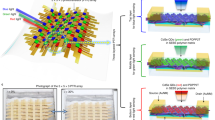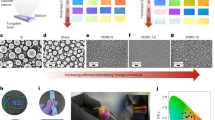Abstract
Chromatic materials such as polydiacetylene change colour in response to a wide variety of environmental stimuli, including changes in temperature, pH and chemical or mechanical stress, and have been extensively explored as sensing devices1,2,3,4. Here, we report the facile synthesis of carbon nanotube/polydiacetylene nanocomposite fibres that rapidly and reversibly respond to electrical current, with the resulting colour change being readily observable with the naked eye. These composite fibres also chromatically respond to a broad spectrum of other stimulations. For example, they exhibit rapid and reversible stress-induced chromatism with negligible elongation. These electrochromatic nanocomposite fibres could have various applications in sensing.
This is a preview of subscription content, access via your institution
Access options
Subscribe to this journal
Receive 12 print issues and online access
$259.00 per year
only $21.58 per issue
Buy this article
- Purchase on Springer Link
- Instant access to full article PDF
Prices may be subject to local taxes which are calculated during checkout




Similar content being viewed by others
Change history
27 September 2009
In the version of this Letter initially published online, Fig. 1a should have been described as a transmission electron microscopy image. This error has been corrected in all versions.
References
Motiei, L., Lahav, M., Freeman, D. & van der Boom, M. E. Electrochromic behavior of a self-propagating molecular-based assembly. J. Am. Chem. Soc. 131, 3468–3469 (2009).
Ahn, D. J. & Kim, J.-M. Fluorogenic polydiacetylene supramolecules: immobilization, micropatterning and application to label-free chemosensors. Acc. Chem. Res. 41, 805–816 (2008).
Nallicheri, R. A. & Rubner, M. F. Investigations of the mechanochromic behavior of poly(urethane-diacetylene) segmented copolymers. Macromolecules 24, 517–525 (1991).
Ryu, S., Yoo, I., Song, S., Yoon, B. & Kim J.-M. A thermoresponsive fluorogenic conjugated polymer for a temperature sensor in microfluidic devices. J. Am. Chem. Soc. 131, 3800–3801 (2009).
Huynh, W. U., Dittmer, J. J. & Alivisatos, A. P. Hybrid nanorod–polymer solar cells. Science 295, 2425–2427 (2002).
Kim, J. Y. et al. New architecture for high-efficiency polymer photovoltaic cells using solution-based titanium oxide as an optical spacer. Adv. Mater. 18, 572–576 (2006).
Lu, Y. et al. Self-assembly of mesoscopically ordered chromatic polydiacetylene/silica nanocomposites. Nature 410, 913–917 (2001).
Jin, H., Heller, D. A., Kim, J.-H. & Strano, M. S. Stochastic analysis of stepwise fluorescence quenching reactions on single-walled carbon nanotubes: single molecule sensors. Nano Lett. 8, 4299–4304 (2008).
Dai, H., Wong, E. W. & Lieber, C. M. Probing electrical transport in nanomaterials: conductivity of individual carbon nanotubes. Science 272, 523–526 (1996).
Lampert, C. M. Chromogenic smart materials. Mater. Today 7, 28–35 (March 2004).
Yao, Y. et al. Temperature-mediated growth of single-walled carbon-nanotube intramolecular junctions. Nature Mater. 6, 283–286 (2007).
Dalton, A. B. et al. Super-tough carbon-nanotube fibres. Nature 423, 703 (2003).
Li, S., He, P., Dong, J., Guo, Z & Dai, L. DNA-directed self-assembling of carbon nanotubes. J. Am. Chem. Soc. 127, 14–15 (2005).
Zhou, X. J., Moran-Mirabal, J. M., Craighead, H. G. & McEuen, P. L. Supported lipid bilayer/carbon nanotube hybrids. Nature Nanotech. 2, 185–190 (2007).
Li, Q. et al. Sustained growth of ultralong carbon nanotube arrays for fiber spinning. Adv. Mater. 18, 3160–3163 (2006).
Bachtold, A. et al. Contacting carbon nanotubes selectively with low-ohmic contacts for four-probe electric measurements. Appl. Phys. Lett. 73, 274–276 (1998).
Zhang, M., Atkinson, K. R. & Baughman, R. H. Multifunctional carbon nanotube yarns by downsizing an ancient technology. Science 306, 1358–1361 (2004).
Hiura, H., Ebbesen, T. W, Tanigaki, K. & Takahashi, H. Raman studies of carbon nanotubes. Chem. Phys. Lett. 202, 509–512 (1993).
Sakamoto, M. et al. Enhanced electrical conductivity of polydiacetylene crystals by chemical doping and ion implantation. J. Appl. Phys. 60, 2788–2796 (1986).
Liu, Y., Yu, Z., Zhang, Y., Guo, D. & Liu, Y. Supramolecular architectures of β-cyclodextrin-modified chitosan and pyrene derivatives mediated by carbon nanotubes and their DNA condensation. J. Am. Chem. Soc. 130, 10431–10439 (2008).
Peng, H. et al. Responsive periodic mesoporous polydiacetylene/silica nanocomposites. J. Am. Chem. Soc. 128, 5304–5305 (2006).
Peng, H. et al. Polydiacetylene/silica nanocomposites with tunable mesostructure and thermochromatism from diacetylenic assembling molecules. J. Am. Chem. Soc. 127, 12782–12783 (2005).
Peng, H., Jain, M., Peterson, D. E., Zhu, Y. T. & Jia, Q. X. Composite carbon nanotube/silica fibers with improved mechanical strengths and electrical conductivities. Small 4, 1964–1967 (2008).
Peng, H. Aligned carbon nanotube/polymer composite films with robust flexibility, high transparency and excellent conductivity. J. Am. Chem. Soc. 130, 42–43 (2008).
Li, Q. W. et al. Structure-dependent electrical properties of carbon nanotube fibers. Adv. Mater. 19, 3358–3363 (2007).
Cheng, Q. & Stevens, R. C. Charge-induced chromatic transition of amino acid-derivatized polydiacetylene liposomes. Langmuir 14, 1974–1976 (1998).
Acknowledgements
This work was supported by the Shanghai Pujiang Program (09PJ1401100) and start-up fund at Fudan University, and partly supported by the US Department of Energy (Los Alamos National Laboratory Directed Research and Development Project). The authors thank M. Jain, J.O. Willis and D.E. Peterson for help with the conductivity measurements and for their critical reading of the manuscript.
Author information
Authors and Affiliations
Contributions
Q.L. contributed materials. X.S., F.C., Y.Z., G.L. and H.P. carried out experiments. X.C., D.C., Y.L., Y.Z. and Q.J. contributed to preparation of the manuscript. H.P. directed the research, analysed the data and wrote the manuscript.
Corresponding author
Supplementary information
Supplementary information
Supplementary information (PDF 578 kb)
Rights and permissions
About this article
Cite this article
Peng, H., Sun, X., Cai, F. et al. Electrochromatic carbon nanotube/polydiacetylene nanocomposite fibres. Nature Nanotech 4, 738–741 (2009). https://doi.org/10.1038/nnano.2009.264
Received:
Accepted:
Published:
Issue Date:
DOI: https://doi.org/10.1038/nnano.2009.264
This article is cited by
-
Long-lived luminescence and photochromic cellulose acetate-based fiber: preparation, characterization, and potential applications
Cellulose (2023)
-
Metal-Backboned Polymer: Conception, Design and Synthesis
Chinese Journal of Polymer Science (2023)
-
Tuning of polydiacetylene phase behavior mixed with cholesterol derivative and its application toward the detection of pathogenic bacteria
Journal of Materials Science (2023)
-
Water stable and matrix addressable OLED fiber textiles for wearable displays with large emission area
npj Flexible Electronics (2022)
-
A review of textile dye-sensitized solar cells for wearable electronics
Ionics (2022)



